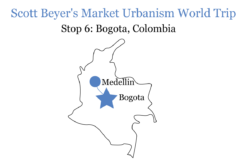Latin America: A Transit Success Story
Cities there have systems that are more innovative, efficient and well-used than the U.S.
Colombia may technically be a “Third World” country, but its big cities have transit systems that surpass many First World ones. Bogota’s an international success story; a place where, for less than $1, one can access bus rapid transit, micro-transit, or even metrocables navigating the hills. Other big Latin American cities mirror Bogota, running systems that are efficient, high-ridership and innovative. Societies with a fraction of U.S. per-capita income produce way better systems.
Mass transit is of course a much bigger part of everyday mobility in LatAm. In Lima and Mexico City, transit’s mode share is 50%. Even in U.S. metros that we think of as transit-reliant, the user experience is worse and ridership lower. Only New York City matches LatAm cities on mode share, while other similar metros have surprisingly low ridership. Chicago’s transit mode share is 12% despite having a population density of over 12,000 residents per square mile. More crucially, systems in these U.S. cities tend to be loud, rickety, dirty, and riddled with outdated technologies that limit throughput.
Meanwhile the LatAm systems, while not “slick” like Asian ones, are quite functional. Here are some regional highlights.
 Bus rapid transit
Bus rapid transit
Bus rapid transit (BRT), wherein large articulated buses operate in dedicated lanes, is common. Mexico City’s Metrobus extends over seven lines and carries hundreds of thousands of daily riders. Dense cities are often associated with rail transit, but Bogota and Curitiba have these entirely bus-based systems, despite Bogota being denser, for instance, than Boston.
Curitiba is the BRT leader. Having visited, I found its system approximates light rail. Loading platforms are separated from the street and equal to bus height (features also seen in Mexico City and Bogota), allowing for step-free boarding. These loading-platforms-cum-stations are enclosed; have off-bus fare payment; and most crucially are connected to dedicated lanes. Curitiba was also an early pioneer in accepting electronic payment (2002) and real-time bus tracking. In the U.S. these features rolled out only recently.
As The Transportation Research Board found, “with good planning and organization busways can carry high volumes of passengers at reasonable commercial speeds—equivalent to those of [light rail] or tram technology under the same operating environment.” Indeed, Curitiba’s system ridership is high—in 2007, a stunning 70% of commuters used the system, and ridership was 5 million, with cheap fares.
Bogota’s TransMilenio is another high-ridership network. Launched in 1999, the system is now “the largest BRT in the world,” and through its existence road fatalities have dropped 92% along its corridors.

Credit: Mario Roberto Duran Ortiz, Wikimedia Commons
Like in Curitiba, development occurred rapidly—from 1999 to 2000, TransMilenio rolled out about 25 miles of dedicated bus lanes. Contrast this with the U.S., where comparably simple bus lane projects require years of process. A proposal in Boston to implement center-running bus lanes on one of the city’s busiest bus corridors was first proposed in 2009, but halted due to community opposition; it was recently reintroduced, but opposition hasn’t waned.
Rail
Along with BRT, rail rapid transit is an important part of mobility in big LatAm cities. In Mexico City, the Metro was the second most-used rapid transit system in North America as of 2017, with annual ridership of nearly 1.7 billion. Santiago’s system spans the city and serves over 670 million riders. Other such systems are found in Sao Paulo, Panama City and Buenos Aires. Bogota is planning a light rail system to accompany the BRT.
Not only are the systems highly-patronized, they’re cheaper to build than U.S. systems. An underway extension of the Santiago Metro spanning nearly 16 miles is slated to cost $2.53 billion, about half the cost of New York’s Second Avenue Subway Phase 1 (which is far shorter). Santiago’s system also received a third of the operating subsidies as Washington, D.C.’s Metro as of 2008. Bogota’s northern light rail expansion, about 29 miles long, is projected to cost $1.8 billion; Boston’s Green Line Extension, a 4.3-mile light rail project in a mostly existing right of way, cost $1.2 billion more and took three decades.
And to reiterate, the user experience is better in these systems. They often have in-station restrooms; comprehensive retail offerings; quieter tracks; television updates; and 1-2 minute headways.
Cable Cars
A particularly innovative measure taken by LatAm cities like Medellin, Bogota and Rio de Janeiro is the use of aerial tramways, often called “cable cars,” to connect the central city transit network to poor hill neighborhoods. LatAm urban geography is generally mountainous and illegal hill settlements have emerged. They become, due to their isolation, hotbeds of gang activity.
Cable car networks are part of an effort to integrate the neighborhoods. They don’t work everywhere: per-vehicle capacity compared to buses and trains is low. But for neighborhoods isolated by geography, they make sense. They’re cheaper than rail—costing between $19-32 million per kilometer to build—and faster than buses. In Medellin, which pioneered the cable car concept, the system replaced bus trips on the shoddy road network of Comuna 13, and at a $71 million costs now carries 16 million riders annually. This unique approach further demonstrates why LatAm transit is successful—it is flexible based on local conditions.
Private Transit
The extensive private transit networks of LatAm likewise contribute to high usage and functionality. Practically all cities, big and small, have private jitney buses with varying degrees of regulation.
Mexico City’s green-and-white peseros, small, generally owner-operated buses, extend beyond the reach of the public subway and buses. They have affordable fares and a collective annual ridership in the tens of millions. Smaller versions of this system exist in Lima, Tegucigalpa, and other stops I visited.
Such organic provision has been regulated out of existence in the U.S. and other developed countries. LatAm regulators have also cracked down on it, sometimes succeeding. Mexico City has sought to restrict peseros on the grounds that they’re old buses with higher emissions. Santiago at one point had a thriving private bus network, but critics objected to the fact it was for-profit and had additional concerns about safety due to drivers competing for riders. Instead of implementing measures to limit dangerous driving, the system was brought under wholesale public control—and ridership ultimately decreased.
Jitneys nonetheless are ubiquitous in LatAm, even if their informality prevents analysts from getting reliable ridership statistics.
*
Some reasons for the difference in U.S. and LatAm transit systems are economic. The U.S. is a wealthy society where people can afford to own cars and live in sprawl. LatAm is a poorer region where car ownership rates are low. This leads to different political and cultural attitudes about transit usage, right-of-way allocation, etc.
But I also sensed when using these systems that, contrary to stereotypes, LatAm public administration is just more effective than ours—at least on this issue. LatAm has less NIMBYism regarding transit or most anything else, which is why lines quickly get built and surrounded by the needed residential density. LatAm has cheaper labor, while U.S. transport projects are riddled with project labor agreements and other union deals. LatAm allows private options to complement public systems, while U.S. transit officials, working from a zero-sum mentality, squash these options to avoid competition.
There’s no innate reason that dense U.S. cities, in particular, should have outdated systems that look Third World compared to LatAm ones. But due to the bureaucracy encoded into our municipal politics, that is how things have gone.
Except where otherwise noted, all images credited to Scott Beyer and The Market Urbanist.
Catalyst articles by Scott Beyer | Full Biography and Publications
